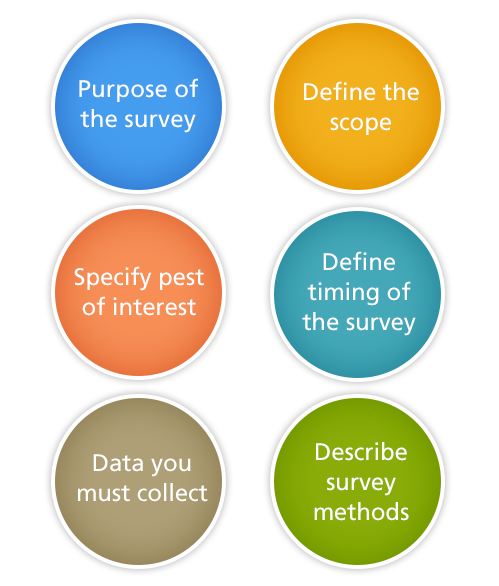Lesson 2: Pest Surveillance Methods
Topic 3: Planning a Survey Program
This topic guides you through the thinking process and steps for planning a survey program.
Objectives:
- Be able to ask the right questions for planning a successful survey
- Learn how to correctly use the information from general surveillance to answer those questions
It is not possible to survey all aspects of agricultural production or even a single crop across an entire country. Therefore, you cannot survey all the barumba berry fields, harvest areas, and transported berries in your country. How do you effectively choose what and where to survey?
Any successful program starts with a plan. The following figures contain the information essential for putting together a survey plan. There are many ways to conduct surveys, but you should consider and plan for the components you see below. Hover your mouse over each circle to explore the components as they pertain to the fire moth example.
Note that some information has already been provided, but some questions still need to be answered in order to complete the fire moth survey plan.
Six Components of a Survey Plan

- Early detection of fire moth in Importland
- Protection of barumba berry production in Importland
- Assurance to other countries that Importland is free of fire moth
Fire moth (Aduro incendium)
Record the following: trap type used, number of samples collected, identification of all species collected, detailed collection locations, collection dates, name of identifier, sampling frequency, assumptions made, and any other relevant information
- Crop
- Geographical area
- Place of production
- Season
Where and to what scale should you survey for fire moth?
- Dates
- Frequency
- Duration
When should you survey for fire moth?
- Sampling
- Diagnostic and reporting procedures
Which methods will help you accurately survey fire moth?
Use information collected from general surveillance and other sources to complete the survey plan. The following is some basic information to consider, and it is grouped by the questions in the figures. Remember, always consider the cost in time and resources before making final decisions about all aspects of a surveillance program.
Now that you have reviewed the information about the fire moth, use your mouse to look at the components again, and consider how the information you just reviewed helped answer the questions originally posed.

- Survey for adult fire moth during the growing season in Importland’s two barumba berry production fields bordering Exportland
- Survey berry packinghouses or cold storages for larvae during each berry harvest in March, May and July.
- Survey areas around ports of entry that could harbor fire moth
Rationale:
Two large barumba berry fields are located along the border with Exportland, a country that has reported the presence of fire moths. Make these two fields the priority for survey of adult fire moth.
Visual surveys are efficient, and packers can be trained quickly to inspect the barumba berries.
Since fire moth is not known to be present in Importland, you should create surveillance sites at places where barumba berries, or host plant material from affected countries enter Importland.

Survey by (a) visually inspecting barumba berries during harvest season, and (b) two geographically limited pest detection trapping surveys in berry fields during the growing season. These field surveys will occur for one week in August and one week in September.
Rationale:
It makes sense to visually inspect the berry fields during the growing season, but it is more cost effective to inspect harvested barumba berries instead.
Surveying adult fire moth in the field is a good idea to aid early detection. However, because the pest is not known to be present in Importland, field surveys for adult moths do not need to be intensive at this time.

- Use a trap and lure to survey adult fire moth
- Inspect harvested fruit and identify all insects found
Rationale:
Commercially produced traps and lures are a familiar and widely accepted way to survey for moths in many countries.
Visual inspection of harvested fruit is a common method for detection of pests.
To continue, select Lesson 3 from the Lessons menu above or click here.